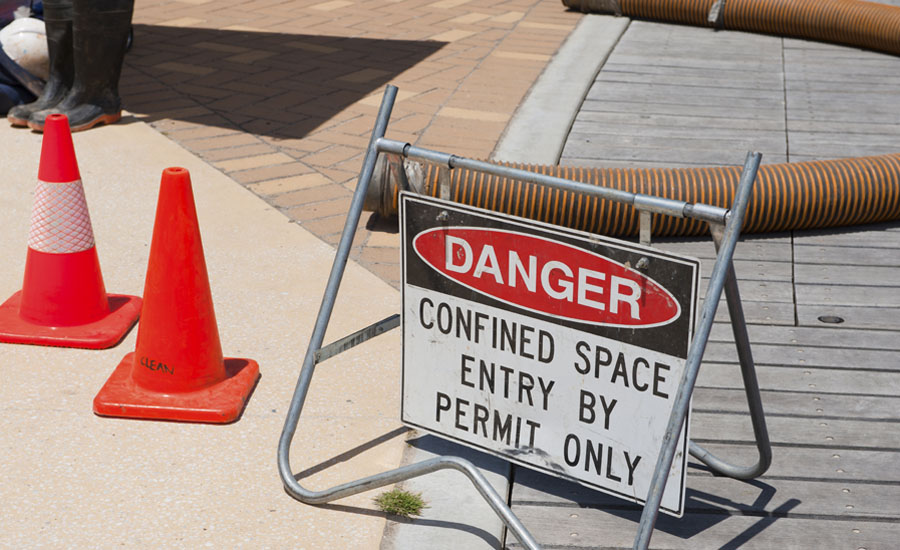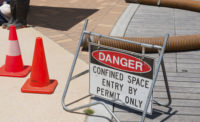A crew foreman – the person responsible for safety at his job site – died as a result of exposure to toxic fumes, an accident that was investigated by the National Institute for Occupational Safety and Health (NIOSH), Division of Safety Research (DSR), through its Fatal Accident Circumstances and Epidemiology (FACE) Project.
According to NIOSH, the man died as the result of exposure to 2-nitiopropane and coal tar pitch vapors. The victim and a co-worker (who became seriously ill) were painting water line sleeves and valves.
Company has a safety policy
The victim, who was the crew foreman, was employed by a general engineering contracting firm that employs approximately 45 people. The firm has a safety policy that outlines procedures for work in confined spaces.
“If these procedures had been followed, the likelihood of this incident occurring would have been reduced, perhaps eliminated,” according to NIOSH.
The crew foreman held weekly "tool box" meetings are used to instruct workers in accident prevention. Each new employee is issued a code of safe practices when hired.
From NIOSH’s investigation:
The engineering contracting firm was contracted to replace a valve in a 72-inch underground water line. The water line had separated due to land subsidence. The company enclosed this portion of the line in a rectangular concrete service area (12' X 15' X 15' deep). The concrete service area was covered with a removable wooden roof with a steel access door (3' X 5' ). Three vents (approximately 6" X 24") were present on two opposite sides of the service area, above ground level. Inside the service area the 72-inch line was reduced to 54 inches and a valve was installed on the concrete-coated steel water line. One of the tasks remaining was to paint the valve and the steel flanges with an epoxy coating that contained 2-nitropropane and coal tar pitch.
The victim and a co-worker began to apply the epoxy coating to water line support rods in a similar water line service area that was located approximately 300 feet from the service area that housed the 54-inch valve. There was no roof over this service area.
Despite complaints, nothing was done
After work, the co-worker complained of nausea and a headache; however, at the start of the shift the following morning (July 2, 7:00 a.m.), the co-worker apparently had recovered and said he felt fine. The victim and co-worker then entered the service area that housed the valve. The access door was left open to provide light for the painting operation. Sometime during the morning a third worker and a safety inspector (employed by the architect/engineering firm overseeing the construction project) entered the service area. Although the third worker and the safety inspector both complained about the "fumes," nothing was done to rectify the situation. At noon the victim and co-worker exited the service area to eat lunch. The co-worker again complained of nausea and a headache. The victim made no such complaints. The victim and co-worker entered the service area after lunch and continued to paint until the end of the work shift (approximately 3:30 p.m.).
Acute liver failure
During the drive home, both men began to complain of nausea and headaches. The victim then vomited into his hardhat. After feeling progressively worse, both men decided to go to the hospital from their homes. They were admitted on the evening of July 2 and were discharged the following day. The victim was re-admitted to the hospital on July 6; he lapsed into a coma and died on July 12 of acute liver failure induced by the inhalation of the 2-nitropropane and coal tar pitch vapors. Although seemingly recovered from the incident, the co-worker has been advised by the attending physician not to return to work due to the fluctuation of his liver enzyme count.
Language barrier
Labels on the protective coating cans clearly state that the coating should be used in confined space "only with adequate forced air ventilation to prevent dangerous concentrations of vapors which could cause death from breathing." The victim stated when assigned this task that he had used this material previously; however, it is doubtful that the victim or the co-worker, who were of Hispanic descent and spoke broken English, fully understood the level of toxicity of the epoxy. A blower, provided at the site for ventilation purposes, was never utilized.
Recommendations/Discussion:
Recommendation #1: Employers should be certain employees are aware of the hazards associated with the tasks they are performing and the materials they are using. Additionally, employees should be aware of all safety procedures to be followed and the reasons for these procedures.
Discussion: Even though the victim stated that he had used this material previously, it is highly unlikely that he fully understood the extent of the toxicity of this substance in a confined space. It is unlikely the victim or the co-worker would have returned to the service area to paint after becoming nauseous and developing headaches had they realized that breathing concentrations of the epoxy vapors could cause death. This may require the communication of information concerning hazards to be made to an employee in a language other than English. Upon issue of the material, supervisory personnel on the job should have explained fully all hazards associated with the use of the epoxy material and should have followed up to determine if the blower that was provided for ventilation purposes was necessary.
Recommendation #2: Employers should implement and enforce existing safety policies.
Discussion: The employer had a written safety policy that included procedures to be followed while working in confined spaces. Had this policy been followed the risk of this fatality would have been greatly reduced. The employer should assure that these safety procedures are fully understood and enforced.



